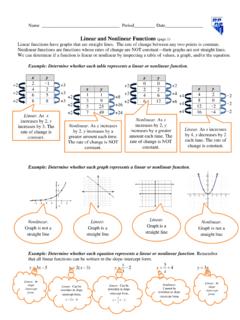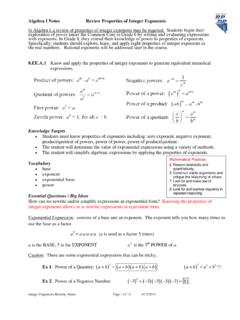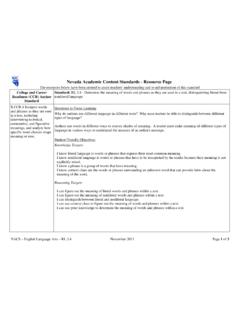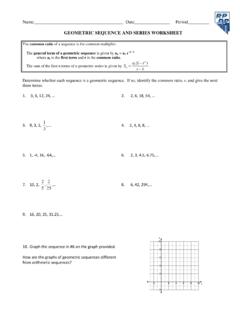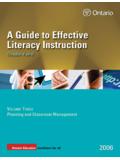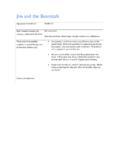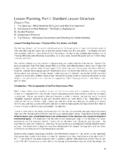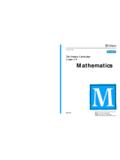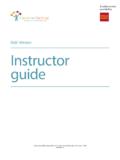Transcription of At RPDP, we support educators through professional ...
1 At RPDP, we support educators through professional development . professional development can occur in a variety of ways: Entire staff trainings, grade level meetings, one-on-one support , etc. We collaborate with administrators and teachers regarding the developing and strengthening math content knowledge, use of best practices in the classroom, we model lessons, and provide support for the use of quality instructional materials. Providing educators with quality resources in regards to instructional materials is a continuous priority. We provide this support through math content overviews, the use of instructional materials, further practice/skill development materials, and through quality assessments/tasks. As we work to create these resources for educators , we may recommend other quality resources from time to time.
2 In recent years, some states have received funds to create quality instructional materials for ALL educators for ALL states to access. We have selected some of those materials that we believe support our vision of quality instructional materials that support teachers in providing a solid mathematical foundation for students. For more elementary math resources please visit . This work is licensed by the MA Department of Elementary & Secondary Education under the Creative Commons Attribution-NonCommercial-ShareAlike Unported License (CC BY-NC-SA ). educators may use, adapt, and/or share. Not for commercial use. To view a copy of the license, visit 11/2013 Page 1 of 80 Problem Solving using Addition & Subtraction Situations Math Grade 2 The following unit contains nine lessons and one Curriculum Embedded Performance Assessment.
3 It addresses the common core math standards , and In this unit, student talk is encouraged to further develop problem-solving skills through real life word problems presented in a variety of situations. Student will be required to represent word problems using models and equations with an unknown in any position. They will also solve problems that involve length and represent whole numbers on a number line in order to show addition and subtraction. This unit assumes that students have had experience modeling simple addition and subtraction problems on a number line. These Model Curriculum Units are designed to exemplify the expectations outlined in the MA Curriculum Frameworks for English Language Arts/Literacy and Mathematics incorporating the Common Core State Standards, as well as all other MA Curriculum Frameworks.
4 These units include lesson plans, Curriculum Embedded Performance Assessments, and resources. In using these units, it is important to consider the variability of learners in your class and make adaptations as necessary. This work is licensed by the MA Department of Elementary & Secondary Education under the Creative Commons Attribution-NonCommercial-ShareAlike Unported License (CC BY-NC-SA ). educators may use, adapt, and/or share. Not for commercial use. To view a copy of the license, visit 11/2013 Page 2 of 80 Table of Contents Stage 1 Desired Results .. 3 Stage 2 - Evidence .. 4 Stage 3 Learning Plan .. 4 Lesson 2: Solving Add to Situations .. 10 Lesson 3: Solving Take from Situations.
5 20 Lesson 4: Solving Put Together/Take Apart Situations .. 28 Lesson 5 Solving Comparison Situations .. 34 Lesson 6: Writing One Step Story Problems .. 39 Lesson 7: Solving Two-Step Word Problems (Part 1) .. 54 Lesson 8: Solving Two-Step Word Problems (Part 2) .. 63 Lesson 9: Writing Two-Step Word Problems .. 69 CEPA #1 Toy Store .. 76 CEPA #2: Playground development Project .. 77 This work is licensed by the MA Department of Elementary & Secondary Education under the Creative Commons Attribution-NonCommercial-ShareAlike Unported License (CC BY-NC-SA ). educators may use, adapt, and/or share. Not for commercial use. To view a copy of the license, visit 11/2013 Page 3 of 80 Stage 1 Desired Results ESTABLISHED GOALS G Operations and Algebraic Thinking Represent and solve problems involving addition and subtraction.
6 1. Use addition and subtraction within 100 to solve one- and two-step word problems involving situations of adding to, taking from, putting together, taking apart, and comparing, with unknowns in all positions, , by using drawings and equations with a symbol for the unknown number to represent the Measurement and Data Relate addition and subtraction to length. 5. Use addition and subtraction within 100 to solve word problems involving lengths that are given in the same units, , by using drawings (such as drawings of rulers) and equations with a symbol for the unknown number to represent the problem. 6. Represent whole numbers as lengths from 0 on a number line diagram with equally spaced points corresponding to the numbers 0, 1, 2 and represent whole-number sums and differences within 100 on a number line diagram.
7 SMP1 Make sense of problems and persevere in solving them SMP2 Reason abstractly and quantitatively SMP3 Construct viable arguments and critique the reasoning of others. SMP4 Model with mathematics Transfer Students will be able to independently use their learning Apply mathematical knowledge to analyze and model mathematical relationships in the context of a situation in order to make decision, draw conclusions, and solve problems. T Meaning UNDERSTANDINGS U Students will understand 1. Solving word problems requires an understanding of the situation and the question to be answered. 2. Addition and subtraction problems can be modeled and solved using various representations. 3. A number shown on a number line represents a distance, in equally spaced units, from a starting point of zero.
8 ESSENTIAL QUESTIONS Q 1. How can pictures or tools, including number lines, help us solve word problems? 2. What does it mean to understand a problem? 3. How do you know when to add or subtract? Acquisition Students will K 1. There is more than one way to represent and solve word problems. 2. The unknown can take any position in an equation and be represented with a symbol. 3. There are different types of addition and subtraction problem situations. 4. Number lines, with equally spaced points corresponding to whole numbers, can be used as a problem solving tool. 5. Academic Vocabulary: part, whole, add, sum, addition sentence, plus, equals, join, subtract, Students will be skilled S 1. Retelling a word problem in their own words. 2. Solving one- and two-step addition and subtraction word problems.
9 3. Writing an addition or subtraction equation or model for any word problem situation. 4. Explaining their thinking orally or in writing using precise mathematical language. 5. Representing whole number sums and 1 See Glossary, Table 1. This work is licensed by the MA Department of Elementary & Secondary Education under the Creative Commons Attribution-NonCommercial-ShareAlike Unported License (CC BY-NC-SA ). educators may use, adapt, and/or share. Not for commercial use. To view a copy of the license, visit 11/2013 Page 4 of 80 SMP5 Use appropriate tools strategically SMP 6 Attend to precision SMP7- Look for and make use of structure difference, subtractions sentence, minus, separate, compare, more , fewer, fact family, equation, unit, number line, length differences within 100 on a number line diagram.
10 Stage 2 - Evidence Evaluative Criteria Assessment Evidence Interpretation: Represent whole-number sums and differences within 100 on a number line diagram Explanation: Show the equation they constructed to solve the problem Application: Solve word problems CURRICULUM EMBEDDED PERFORMANCE ASSESSMENT (PERFORMANCE TASKS) CEPA #1 Goal: Your task is to decide how to spend a $100 gift card at a toy store. Product: A written explanation showing your math, including an equation and a number line model, to help your parent understand your reasoning for how you can or can t buy three toys instead of two. Criteria for Success: Your work will be judged by the attached rubric. CEPA #2 Playground development Project Goal: To design a new playground for the : A written explanation describing how to help the inspector figure out the missing value and if his walking path is the correct length.




